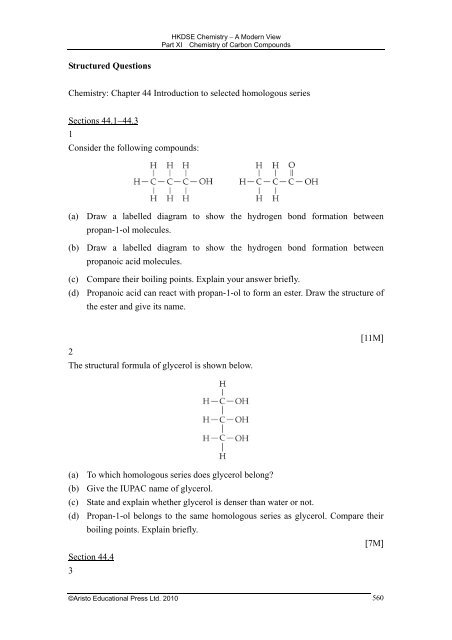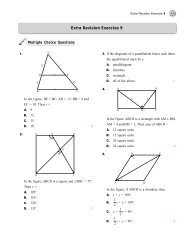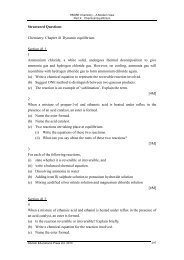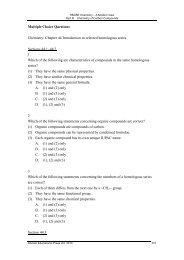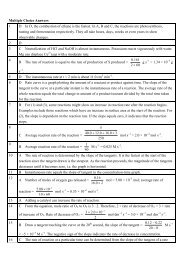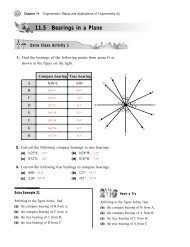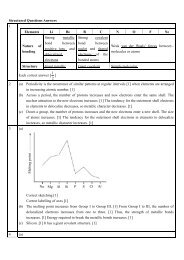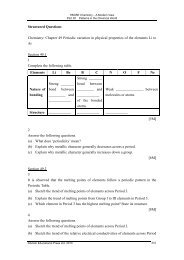Structured Questions..
Structured Questions..
Structured Questions..
You also want an ePaper? Increase the reach of your titles
YUMPU automatically turns print PDFs into web optimized ePapers that Google loves.
HKDSE Chemistry A Modern ViewPart XI Chemistry of Carbon Compounds<strong>Structured</strong> <strong>Questions</strong>Chemistry: Chapter 44 Introduction to selected homologous seriesSections 44.144.31Consider the following compounds:(a) Draw a labelled diagram to show the hydrogen bond formation betweenpropan-1-ol molecules.(b) Draw a labelled diagram to show the hydrogen bond formation betweenpropanoic acid molecules.(c) Compare their boiling points. Explain your answer briefly.(d) Propanoic acid can react with propan-1-ol to form an ester. Draw the structure ofthe ester and give its name.2The structural formula of glycerol is shown below.[11M](a) To which homologous series does glycerol belong?(b) Give the IUPAC name of glycerol.(c) State and explain whether glycerol is denser than water or not.(d) Propan-1-ol belongs to the same homologous series as glycerol. Compare theirboiling points. Explain briefly.[7M]Section 44.43©Aristo Educational Press Ltd. 2010 560
HKDSE Chemistry A Modern ViewPart XI Chemistry of Carbon CompoundsWith reference to the following compounds:Butane, Butan-1-ol, Butanoic acid, 2-methylpropane(a) Write the structural formula for each of the above compounds.(b) Which of the above compounds is/are gas(es) under room conditions?(c) Arrange the above compounds in ascending order of boiling points. Explain youranswer.[13M]4After an animal died, bacteria would break down protein of the body. The dead bodystarted to produce some amines in its tissues. For example, NH 2 (CH 2 ) 4 NH 2 andNH 2 (CH 2 ) 5 NH 2 are found in decaying animal flesh. These amines are partlyresponsible for the unpleasant smell of dead bodies.(a) Give the IUPAC names of the two amines mentioned above.(b) When a fish died, dimethylamine and trimethylamine were found in theirdecaying flesh. Write the structural formulae of these two amines. (Hint: one ofthem is a secondary amine and the other is a tertiary amine.)(c) Draw a labelled diagram to show that NH 2 (CH 2 ) 4 NH 2 is soluble in water.(d) Draw a labelled diagram to show the hydrogen bond formation betweenNH 2 (CH 2 ) 4 NH 2 molecules.[8M]5Ethyl butanoate is a chemical which can be used to manufacture hand creams. It has apineapple smell.(a) Which homologous series does it belong to? Explain briefly.(b) Write the structural formula for ethyl butanoate.(c) Is ethyl butanoate an acid derivative? Explain briefly.(d) Draw a labelled diagram to show the experimental set-up for preparing ethylbutanoate.(e) Consider the following information:Hexanoic acid Ethyl butanoateBoiling point 186C 121CRelative molecular mass 116 116Explain briefly why hexanoic acid has a much higher boiling point than ethylbutanoate.[12M]©Aristo Educational Press Ltd. 2010 561
HKDSE Chemistry A Modern ViewPart XI Chemistry of Carbon Compounds6Compounds X, Y and Z are organic compounds containing 3, 4 and 5 carbon atomsrespectively.In an experiment, compounds X, Y and Z were tested with the following reagents. Theexperimental results were shown below:Test Compound X Compound Y Compound ZBromine in1,1,1-trichloroethanein the darkBrown solutionturned tocolourlessNo observablechangeBrown solutionturned tocolourlessSodium carbonatesolutionNo observablechangeSome colourlessgas evolvedNo observablechange(a) (i) Which of the above compounds have the same functional group?(ii) What is the functional group?(iii) Which homologous series do they belong to?(iv) What is the general formula for the two compounds?(b) Give a possible structural formula of compound Y.[6M]7CH 2 O 2 and C 2 H 4 O 2 are organic compounds which react with magnesium strips togive colourless gas.(a) What is the colourless gas evolved?(b) What is the general formula of these compounds?(c) Which homologous series do they belong to?(d) Give the functional group of these compounds. Suggest another chemical test toidentify the functional group of these compounds.(e) Name the third and fourth members of this homologous series.[8M]8Consider the following compounds:Hex-2-ene, Hexan-3-ol, Hexanal, Hexan-2-amine(a) Write the structural formula for each of the above compounds.(b) Which of the above compounds are soluble in water? Explain briefly.(c) Arrange the above compounds in increasing order of boiling points. Explain youranswer.[12M]9©Aristo Educational Press Ltd. 2010 562
HKDSE Chemistry A Modern ViewPart XI Chemistry of Carbon CompoundsA saturated carboxylic acid has the relative molecular mass of 88.0.(a) Give the general formula of carboxylic acids.(b) Deduce the molecular formula of the carboxylic acid.(c) Name and draw all the possible structures of the carboxylic acid.[8M]10Consider the following compounds:Chloroethane, Ethanol, Ethene, Bromoethane(a) Classify the compounds into different homologous series.(b) Which of the above compounds is/are soluble in water? Explain briefly.(c) Arrange the compounds in increasing order of boiling points. Explain youranswer.[11M]11Vanillin is a key ingredient in vanilla ice-cream. The structure of vanillin is shownbelow:(a) Identify TWO functional groups of vanillin.(b) To which homologous series does vanillin belong?(c) State whether vanillin is soluble in water or not. Explain briefly.(d) Suggest another use of vanillin.[6M]12Butanal is an organic compound and also known as butyraldehyde.(a) Write the condensed formula for butanal.(b) Butanal can be produced by the process known as hydroformylation of propene(CH 3 CH=CH 2 ), which also includes hydrogen and carbon dioxide as thereactants. Write a chemical equation for the reaction.(c) Suggest a hazard warning label for butanal.(d) A student stated that the condensed formula for butanal should NOT be writtenas CH 3 CH 2 CH 2 COH. Comment on his statement.©Aristo Educational Press Ltd. 2010 563
HKDSE Chemistry A Modern ViewPart XI Chemistry of Carbon Compounds[6M]13(a) State the meaning of ‘homologous series’.(b) State whether (i) the physical properties and (ii) chemical properties of themembers of a homologous series are the same.(c) Identify the functional groups of each of the following compounds and state thehomologous series that each of them belongs to.(i) CH 3 CH 2 CHO(ii) CH 3 (CH 2 ) 2 COCH 3(iii) CH 3 CONH 214With reference to the following compounds:Fluoromethane, Chloromethane, Bromomethane, Iodomethane(a) Write the structural formula for each of the above compounds.[10M](b) Which of the above compounds is/are liquid(s) under room conditions?(c) Which of the above compounds is/are gas(es) under room conditions?(d) Compare the boiling points of these compounds with methane. Explain briefly.[11M]15(a) Amines can be classified as primary, secondary or tertiary. Identify the followingamines in terms of the above classification. Explain briefly.(i) CH 3 NH 2(ii)(iii) (CH 3 ) 3 N(b) (i) Explain why primary amines have lower boiling and melting points thanalcohols and carboxylic acids with a similar relative molecular mass.(ii) Draw a labelled diagram to show the hydrogen bond formation betweenprimary amine molecules.(c) Explain why ethanoic acid in the vapour state has a molecular weight of 120.Illustrate the answer with the help of a labelled diagram.16[12M]©Aristo Educational Press Ltd. 2010 564
HKDSE Chemistry A Modern ViewPart XI Chemistry of Carbon CompoundsConsider the following compounds:Compound A Compound B Compound C Compound D(a) Name the homologous series that each of them belongs to.(b) Which of the above compounds can form hydrogen bonds among theirmolecules?(c) Arrange the above compounds in descending order of boiling points. Explainyour answer.(d) (i) Which two of the above compounds can react to form an ester?(ii) Name the ester formed.(iii) Comment on the boiling point of the ester formed in (i).[16M]17The relative molecular mass of a saturated and branched-chain carboxylic acid is 88.0.(a) Draw the structure of the carboxylic acid.(b) Give the IUPAC name of the carboxylic acid.(c) A dimer can be formed between two carboxylic acid molecules. Draw a labelleddiagram to show the dimer.[5M]18Consider the following compounds:CH 3 (CH 2 ) 2 NH 2 , CH 3 COOH(a) Classify the compounds into different homologous series.(b) For each of the above compounds, describe the formation of hydrogen bondsbetween their molecules.(c) Hence, compare their boiling points. Explain briefly.[9M]19For each of the following compounds, write the(i) structural formula; and(ii) condensed formula.(a) 2,2-dimethylpropane(b) 2-methylbut-1,3-diene©Aristo Educational Press Ltd. 2010 565
HKDSE Chemistry A Modern ViewPart XI Chemistry of Carbon Compounds(c) 2-bromo-3-chloropropene(d) Butanoic acid(e) Propanone[10M]Section 44.520Consider the following compounds:3-methylbutanone, 2-methylbutanoic acid, 2-methylbutan-1-ol, 2-methylbutanal(a) Write the structural formula for each of the above compounds.(b) Which of the above compounds have hydrogen bonds between their molecules?(c) Which of the above compounds has the highest boiling point? Explain youranswer briefly.[11M]21Give the IUPAC names for the following compounds:(a)(b)(c)(d)©Aristo Educational Press Ltd. 2010 566
HKDSE Chemistry A Modern ViewPart XI Chemistry of Carbon Compounds(e)(f)22Write the structural formula for each of the following compounds:(a) 3-ethyl-3-methylpent-1-ene[6M](b) Butane-1,4-diol(c) 2-aminopropanoic acid(d) Sodium 2-hydroxypropanoate(e) Methyl ethanoate(f)2,6,6-trimethylhept-2-ene23(a) Give the IUPAC name of the following compounds:(i)[6M](ii)(iii)©Aristo Educational Press Ltd. 2010 567
HKDSE Chemistry A Modern ViewPart XI Chemistry of Carbon Compounds(iv)(b) Write the structural formulae of the following compounds:(i) 3-oxobutanoic acid(ii) 4-bromo-3-methylpentanal(iii) 2-amino-3-hydroxypropanoic acid(iv) methyl 3-chloro-3-methylbutanoate24For each of the following compounds, write the(i) structural formula; and(ii) condensed formula.(a) 4-methylpent-3-en-2-one[8M](b) Pent-3-en-1-ol(c) Butanedione(d) 4-amino-4-hydroxy-2-oxobutanal(e) Propan-1-amineSection 44.625Consider the following compounds:CH 3 COOH, CH 3 COCH 3 , CH 3 CH(OH)CH 3 , CHCl 3 , HCHO(a) Write the trivial name for each of the above compounds.(b) Write the structural formula for each of the above compounds.(c) Explain why CH 3 COOH has a higher boiling point than HCHO.Chemistry: Chapter 45 Isomerism[10M][14M]Section 45.126A and B are isomers having the molecular formula C 4 H 8 O 2 . A and B have different©Aristo Educational Press Ltd. 2010 568
HKDSE Chemistry A Modern ViewPart XI Chemistry of Carbon Compoundschemical properties. A belongs to esters while B belongs to carboxylic acids.(a) (i) Draw the structural formulae of all possible isomers of A and name them.(ii) State the type of structural isomers mentioned in (i).(b) (i) Draw the structural formulae of all possible isomers of B and name them.(ii) State the type of structural isomers mentioned in (i).(c) Which type of isomers are A and B?[13M]Section 45.227State and explain whether the following compounds could exhibit geometricalisomerism or/and enantiomerism. For each compound that exhibits geometricalisomerism or/and enantiomerism, draw the structures/three-dimensional structures ofall possible isomers.(a) but-2-ene(b) 2,4-dimethylpentenedioic acid(c) 2-chlorobutane[17M]28State and explain whether the following compounds could exhibit geometricalisomerism or/and enantiomerism. For each compound that exhibits geometricalisomerism or/and enantiomerism, draw the structures/three-dimensional structures ofall possible isomers.(a) CH 3 CHClCH=CH 2(b) CH 3 CH=CHCHCH 3 COOH29Mecoprop is a common herbicide found in many household weed killers.It has the following structure:[12M](a) Copy the structure of mecoprop, and mark the chiral carbon atom(s) with anasterisk.©Aristo Educational Press Ltd. 2010 569
HKDSE Chemistry A Modern ViewPart XI Chemistry of Carbon Compounds(b) Student A stated that the pair of enantiomers of mecoprop can be distinguishedby simply comparing their boiling points and melting points. Comment on hisstatement.(c) Student B stated that the plane of polarized light is not rotated by a mixture of thepair of enantiomers of mecoprop. Comment on his statement.[5M]30Tartaric acid is an organic acid. It occurs naturally in many plants, especially grapesand bananas. It has the following structure:(a) Give the IUPAC name of tartaric acid.(b) Copy the structure of tartaric, and mark the chiral carbon atom(s) with anasterisk.(c) Suggest a test to distinguish the enantiomers of tartaric acid. Explain briefly.[5M]31Glutaconic acid is an organic dicarboxylic acid with a molecular formula of C 5 H 6 O 4 .It is one of the metabolites in human body. Excess level of glutaconic acid in humanbody may lead to brain damage (and also other organs). The structure oftrans-glutaconic acid is shown below:(a) Give the IUPAC name of glutaconic acid.(b) State the meaning of stereoisomerism.(c) Which type of stereoisomerism does glutaconic acid exhibit?(d) Draw the other stereoisomer of glutaconic acid.(e) Which of the stereoisomers of glutaconic acid has a higher melting point?Explain your answer.(f) Which of the stereoisomers of glutaconic acid is more soluble in water? Explainyour answer with the help of appropriate diagrams.32[15M]©Aristo Educational Press Ltd. 2010 570
HKDSE Chemistry A Modern ViewPart XI Chemistry of Carbon CompoundsCompound A is an organic compound with the molecular formula C 5 H 10 O 2 and itexhibits stereoisomerism. The stereoisomers are optically active and they react withsodium hydrogencarbonate solution to give a colourless gas.(a) How do we measure the optical activity of compound A?(b) Which types of stereoisomerism does compound A exhibit?(c) Deduce the structural formula of compound A.(d) Polarized light was passed through a solution of compound A. However, theplane of polarized light did not rotate. Explain the observation.[7M]33Compounds A and B have the same molecular formula C 6 H 12 . However, they showdifferent chemical properties. Compound A can decolorize an acidified potassiumpermanganate solution while compound B cannot.(a) Which functional group does compound A contain?(b) (i) Draw the structural formulae of a pair of geometrical isomers of compoundA and name them.(ii) Draw the three-dimensional representations of a pair of enantiomers ofcompound A.(c) Draw the structural formula of compound B. (Hint: Compound B has a cyclicring structure.)[8M]34In an experiment, butane reacted with bromine in 1,1,1-trichloromethane to giveorganic compounds with molecular formula C 4 H 9 Br.(a) State the condition necessary for the reaction.(b) (i) Give the structural formulae of all possible isomers of C 4 H 9 Br formed fromthe above reaction and name them.(ii) Which types of isomerism does C 4 H 9 Br exhibit? Explain briefly.(c) Give another structural formula of C 4 H 9 Br which is not formed from the abovereaction.[10M]©Aristo Educational Press Ltd. 2010 571
HKDSE Chemistry A Modern ViewPart XI Chemistry of Carbon Compounds35Lactic acid is an organic compound with a condensed formula of CH 3 CHOHCOOH. It isa chemical compound that plays an important role in many biological processes.(a) Give the IUPAC name of lactic acid.(b) (i) Which type of stereoisomerism does lactic acid exhibit? Explain briefly.(ii) Draw the three-dimensional structures of the stereoisomers of lactic acid.(c) A student stated that the stereoisomers of lactic acid can be distinguished bycomparing their boiling points and melting points. Comment on his statement.[10M]36Alanine is a non-essential amino acid which can be manufactured by the human body.It has the following structure:(a) Give the IUPAC name of alanine.(b) (i) Which type of stereoisomerism does alanine exhibit? Explain briefly.(ii) Draw the three-dimensional structures of the stereoisomers of alanine.(c) Suggest a test to distinguish the stereoisomers of alanine. Explain briefly.[8M]37Compound X is an alkene with a phenyl group. The molecular formula of X is C 9 H 10 .(Hints: The molecular formula of phenyl group is C 6 H 5 , where the six carbon atomsare arranged in a cyclic ring structure.)The structural formula of one of the possible isomers of X is shown below:(a) State the meaning of ‘isomer’.(b) (i) Give the structural formulae of all other possible isomers of X.(ii) Which of the isomers mentioned in (i) are geometrical isomers?[6M]38Compound Y is an organic compound with a phenyl group and an ester group. Themolecular formula of Y is C 9 H 10 O 2 . (Hints: The molecular formula of phenyl group isC 6 H 5 , where the six carbon atoms are arranged in a cyclic ring structure.)©Aristo Educational Press Ltd. 2010 572
HKDSE Chemistry A Modern ViewPart XI Chemistry of Carbon CompoundsThe structural formula of one of the possible isomers of Y is shown below:Give the structural formulae of all other possible isomers of Y.[5M]39Our hair, skin and muscle contain proteins. Proteins are polymers that comprise a longsequence of amino acid units. Each amino acid molecule has a central carbon atomwhich forms covalent bonds with an amino group (NH 2 ) and a carboxyl group(COOH). The structure of an amino acid molecule is shown below:(a) State and explain whether the amino acid molecule is chiral or achiral if R is amethyl group (CH 3 ). If appropriate, mark the chiral carbon atom with anasterisk.(b) Which type of stereoisomerism does the amino acid molecule in (a) exhibit?Explain briefly.(c) Draw the three-dimensional representations of the stereoisomers of the aminoacid in (a).(d) Suggest a test to distinguish the stereoisomers of the amino acid in (a). Explainbriefly.[9M]40For each of the following compounds,(i) draw the structural formula of the compound and if appropriate, mark any chiralcarbon atoms with an asterisk; and(ii) state and explain whether the compound could exhibit enantiomerism.(a) 3-methylpent-1-yne(b) 2-methylbutanal(c) 3-methylpentan-2-one41[12M]©Aristo Educational Press Ltd. 2010 573
HKDSE Chemistry A Modern ViewPart XI Chemistry of Carbon Compounds2,4-dichloro-1,5-difluoropentan-3-one could exhibit enantiomerism.(a) State the meaning of enantiomerism.(b) Explain why 2,4-dichloro-1,5-difluoropentan-3-one could exhibitenantiomerism.(c) Draw the structural formula of 2,4-dichloro-1,5-difluoropentan-3-one and showall possible chiral carbon atom(s) by an asterisk.(d) Draw the three-dimensional representations of the enantiomers of2,4-dichloro-1,5-difluoropentan-3-one.[8M]42Compound A is an alkene with the molecular formula C 2 H 2 F 2 and it exhibitsgeometrical isomerism.(a) Draw the structural formulae of geometrical isomers of A and name them.(b) Which isomer has a higher boiling point? Explain your answer.(c) Which isomer has a higher melting point? Explain your answer.[14M]43A student stated that an organic compound with a molecular formula C 3 H 7 OCl couldexhibit enantiomerism only.Comment on his statement. Explain your answer with appropriate structural formulaeof all possible isomers.[9M]44Consider the following compounds:3-bromobut-1-ene, but-2-enoic acid, 1-chloropropan-1-ol(a) Which of the above compounds could undergo addition reaction(s)? Explainbriefly.(b) (i) Which two of the above compounds could react to give an ester?(ii) Write a chemical equation for the esterification.(c) Which of the above compounds could exhibit geometrical isomerism? Explainyour answer with appropriate structural formulae of all possible geometricalisomers.(d) Which of the above compounds could exhibit enantiomerism? Explain youranswer with appropriate three-dimensional representations of all possibleenantiomers.©Aristo Educational Press Ltd. 2010 574
HKDSE Chemistry A Modern ViewPart XI Chemistry of Carbon CompoundsChemistry: Chapter 46 Typical reactions of various functional groups[17M]Sections 46.146.345The reaction between but-1-ene and hydrogen bromide gives rise to compounds A andB. Compound B is the minor product.(a) State the type of the above reaction.(b) Identify compounds A and B.(c) Which type of stereoisomerism does compound A exhibit? Explain briefly.(d) Compound A and compound B is a pair of structural isomers. Which type ofstructural isomers are they?[6M]Sections 46.446.546According to Markovnikov’s rule, the reaction between prop-1-ene and hydrogeniodide may give rise to two products.(a) (i) State Markovnikov’s rule.(ii) State the major and minor products of the above reaction.(b) The major product mentioned in (a)(ii) reacts with sodium hydroxide solution togive compound X. Then compound X is treated with reagent Y at 180C to giveprop-1-ene.(i) Identify compound X.(ii) Write a balanced equation for the reaction between the major product andsodium hydroxide solution.(iii) Identify reagent Y.[7M]47Ethanol is used as the starting material for preparing ethanoic acid in a laboratory.It is known that ethanol is first oxidized to ethanal and is then further oxidized toethanoic acid.(a) (i) Briefly describe how to carry out the oxidation. In your answer, state thereagent and condition required.(ii) State any observable changes during the oxidation. Explain briefly.(b) Suggest how to oxidize ethanol to ethanal only by preventing it from furtherbeing oxidized to ethanoic acid.[7M]©Aristo Educational Press Ltd. 2010 575
HKDSE Chemistry A Modern ViewPart XI Chemistry of Carbon Compounds48In an experiment, a sample of propan-1-ol was mixed with concentrated hydrochloricacid in a boiling tube. Two layers were observed in the boiling tube after theexperiment.(a) Write a chemical equation for the reaction.(b) Identify the two layers. Explain your answer.(c) A student suggested that the above approach can also be used to make aniodoalkane by heating an alcohol with solid potassium iodide and concentratedsulphuric acid. Comment on his suggestion.[8M]49Cyclohexene can be synthesized from cyclohexane through the following syntheticroute:Stage 1 Stage 2 Stage 3(a) State the reagents and conditions required in each stage.(b) State the type of reaction involved in each stage.(c) Stage 1 may give a mixture of chloroalkanes. Suggest a way to avoid thishappens.(d) Suggest another way that can prepare the cyclohexene fromhydroxycyclohexane.[10M]50A student prepared propanal by heating a mixture of propan-1-ol and acidifiedpotassium dichromate solution under reflux. However, he discovered that the productobtained was propanoic acid rather than propanal.(a) Explain why the product obtained was propanoic acid rather than propanal.(b) Suggest how he could obtain propanal from the above reaction.(c) Suggest another reagent which could replace acidified potassium dichromatesolution in the above reaction.[5M]Section 46.651Consider the following pairs of compounds:(a) Propane and propene(b) Propanal and propanone©Aristo Educational Press Ltd. 2010 576
HKDSE Chemistry A Modern ViewPart XI Chemistry of Carbon Compounds(c) Butan-2-ol and 2-methylpropan-2-olIn each case, suggest a chemical test to distinguish between the compounds. In youranswer, state the reagents required and any observable changes.[6M]52In a laboratory preparation of propene, propanone was used as the starting material.The following reactions were carried out.Reaction 1: Propanone was first mixed with reagent A. Then the reaction mixture wastreated with reagent B to give propan-2-ol.Reaction 2: Propan-2-ol was treated with reagent C at 180C to give propene.(a) (i) Identify reagents A and B.(ii) State the type of reaction 1.(iii) Suggest how to separate propan-2-ol from the product mixture in reaction 1.(b) (i) Identify reagent C.(ii) State the type of reaction 2.[6M]53Consider the following reactions:(a) Identify compounds A, B and C.(b) In a laboratory preparation of compound C, compound B was mixed withacidified potassium dichromate solution and gently heated under reflux.(i) State any observable changes during the reaction. Explain your answer.(ii) State TWO precautions of using reflux apparatus.(iii) A student stated that propanoic acid could be obtained if the time for refluxwas extended. Comment on his statement.[9M]54In a laboratory preparation of an ester, propanal and bromoethane were used as thestarting materials. Propanal was oxidized to compound A by mixing with reagent B.Bromoethane reacted with sodium hydroxide solution to give compound C andcompound D. Then, compound A reacted with compound C to give an ester.(a) Identify compound A and reagent B.(b) (i) Identify compounds C and D.(ii) Write a balanced chemical equation for the reaction between bromoethaneand sodium hydroxide solution.©Aristo Educational Press Ltd. 2010 577
(c) (i)Name the ester formed.HKDSE Chemistry A Modern ViewPart XI Chemistry of Carbon Compounds(ii) State the reagent and condition required for forming the ester.(d) A student suggested that propanone can replace propanal for the above reaction.Comment on his suggestion.[11M]55Compounds A and B is a pair of structural isomers with molecular formula C 3 H 8 O.When compounds A and B are heated with reagent X respectively, both of them givepropene. However, when they react with acidified potassium dichromate solutionrespectively, they give different products.(a) Give the condensed formulae of two structural isomers.(b) Which type of structural isomers are they?(c) What is reagent X?(d) Write chemical equations for the reactions between acidified potassiumdichromate solution and the two isomers respectively.[6M]56For each of the following pairs of compounds, suggest a chemical test to distinguishbetween them. In your answer, state the corresponding reagent(s) and condition(s)required and any observable changes.(a) 2-methylpropan-2-ol and butan-2-ol(b) Propanone and propanal(c) Bromoethane and chloroethane[10M]57Copper(II) oxide is an oxidizing agent which can oxidize alcohols to ketones oraldehydes. For example, propan-1-ol and propan-2-ol can be oxidized to propanal andpropanone respectively.(a) State the products formed when butan-1-ol and butan-2-ol are oxidized bycopper(II) oxide respectively.(b) Suggest a chemical test to distinguish between propanal and propanone. In youranswer, state the reagent and condition required and any observable changes.(c) Explain why propanone has a lower boiling point than propan-2-ol.(d) Hence, suggest how to separate propanone from the mixture of propan-2-ol andpropanone.[12M]58Consider the following reactions:©Aristo Educational Press Ltd. 2010 578
HKDSE Chemistry A Modern ViewPart XI Chemistry of Carbon CompoundsReaction 1: (CH 3 ) 2 CHCOOH + Reagent A in dry ether + Reagent B Compound CReaction 2: Compound C + Concentrated H 2 SO 4 at 180C (CH 3 ) 2 C=CH 2 + H 2 O(a) Identify reagents A and B.(b) State the name and write the condensed formula of compound C.(c) Explain why reagent A should be used in dry ether.[6M]Section 46.759Consider the following compounds:Propanone, butanoic acid, 2,2-dimethylpropanol(a) (i) Which two of the above compounds can react to form an ester?(ii) State the reagent and condition required for the formation of the ester.(iii) Give the IUPAC name of the ester.(b) (i) Which of the above compounds can be reduced to alcohol(s)?(ii) State the reagents required for the reduction in (b)(i).(iii) Give the IUPAC name(s) of the alcohol(s) formed from reduction of thecompounds mentioned in (b)(i).[11M]60In a laboratory, butanoic acid was used as the starting material for preparing but-1-ene.The overall process involving two steps is shown below:Step 1: Butanoic acid + reagent A + reagent B Compound CStep 2: Compound C + reagent D at 180C but-1-ene(a) (i) Identify reagents A and B.(ii) Identify compound C.(iii) A student suggested that butanoic acid should be mixed with reagents A andB at the same time in step 1. Comment on his suggestion.(b) Identify reagent D.(c) But-1-ene obtained in step 2 reacted with hydrogen chloride to give twoproducts.(i) What were the two products?(ii) Which one was the major product? Explain briefly.[13M]61Compound A is an organic compound with a relative molecular mass of 60.0. It canreact with sodium carbonate solution to give a salt, water and a colourless gas whichcan turn limewater to milky. It can also react with propan-1-ol to give apleasant-smelling liquid compound B.©Aristo Educational Press Ltd. 2010 579
HKDSE Chemistry A Modern ViewPart XI Chemistry of Carbon Compounds(a) Identify compound A. Explain your answer.(b) Write a chemical equation for the reaction between compound A and sodiumcarbonate solution.(c) (i) Identify compound B.(ii) State the reagent and condition required for the reaction between compoundA and propan-1-ol.[9M]62Three unlabelled test tubes, A, B and C containing propanoic acid, propene andpropan-1-ol respectively were tested by reacting with different reagents. The resultswere tabulated below:Mixed with bromine in organic Mixed with sodium carbonatesolventsolutionA Red-orange mixture turned to No observable changecolourlessB No observable change Colourless gas bubbles evolvedC No observable change No observable change(a) Identify the compounds in each of the test tubes. Explain your answer.(b) (i) Which two of the above compounds can react to form an ester?(ii) State the reagent and condition required for the esterification.(iii) Name the ester formed.[11M]Section 46.863Propyl methanoate can undergo hydrolysis in either acidic or alkaline medium.In fact, it is often hydrolysed in alkaline medium in the laboratory. This reaction isknown as alkaline hydrolysis.(a) State the meaning of hydrolysis.(b) (i) Suggest an alkali used for the alkaline hydrolysis.(ii) State the function of the alkali suggested in (i) in hydrolysis.(c) Name the products formed from the alkaline hydrolysis of propyl methanoate.(d) Suggest ONE industrial application of alkaline hydrolysis of esters.[6M]Section 46.964In a laboratory preparation of propan-1-ol, propanamide was used as the startingmaterial. The following reactions were carried out.©Aristo Educational Press Ltd. 2010 580
HKDSE Chemistry A Modern ViewPart XI Chemistry of Carbon CompoundsReaction 1: Propanamide was heated under reflux with dilute sulphuric acid to givecompound A and compound B.Reaction 2: Compound A was first mixed with reagent C. Then the reaction mixturewas treated with reagent D to give propan-1-ol.(a) (i) Identify compounds A and B.(ii) State the type of reaction 1.(b) (i) Identify reagents C and D.(ii) State the type of reaction 2.[6M]65Consider the following reactions:(a) Give the structural formulae for compounds A, B and C.(b) Name the types of reactions 1, 2 and 3.[6M]66(a) State the reagents and conditions required to carry out the following reactions:(i)(ii)(iii)(b) Write the structural formulae of the products of the following reactions:(i)©Aristo Educational Press Ltd. 2010 581
HKDSE Chemistry A Modern ViewPart XI Chemistry of Carbon Compounds(ii)67Consider the following compounds:[8M]Compound A Compound B Compound C(a) Give the IUPAC name of compounds A, B and C.(b) Write a chemical equation for each of the following reactions:(i) Mixing compound A with acidified potassium dichromate solution.(ii) Heating compound B with sodium hydroxide solution under reflux.(iii) Heating compound C with dilute hydrochloric acid under reflux.(c) State the meaning of hydrolysis. Which of the reactions in (b) is/are hydrolysis?(d) One of the products in the reaction of (b)(iii) can be converted back to compoundC. Write a synthetic route for the conversion.68Consider the following reactions:[15M](a) State the name and write the structural formula of compound A.(b) Compound A is separated from the above product mixture. It is then heatedunder reflux with dilute sodium hydroxide solution to give two products. Whatare the two products?[4M]Chemistry: Chapter 47 Inter-conversions of carbon compoundsSection 47.169In each of the following conversions, draw the synthetic route with the corresponding©Aristo Educational Press Ltd. 2010 582
HKDSE Chemistry A Modern ViewPart XI Chemistry of Carbon Compoundsintermediates, reagents and conditions required for each step.(a) A three-step synthesis of 1-bromopropane from methyl propanoate.(b) A three-step synthesis of 3-methylbutanone from 3-methylbut-1-ene.(c) A four-step synthesis of propane from propanamide.[17M]70Suggest a synthetic route (not more than four steps) with the correspondingintermediates, reagents and conditions for each of the following conversions.(a) Propanamide propane(b) Methyl propanoate 2-bromopropane[14M]71Suggest a synthetic route (not more than three steps) for each of the followingconversions. In your answer, state the corresponding intermediates, reagents, andconditions required for each step.(a) Propan-1-ol to propane(b) Propane to propan-1-ol(c) Propanone to 2-bromopropane(d) Ethanol to methyl ethanoate(e) Butan-1-ol to butanamide[15M]72Consider the following compounds:1-chloropropane, 2-chloropropane(a) (i) Which of the above compounds can be converted to an amide in not morethan four steps?(ii) Draw the synthetic route with the corresponding intermediates, reagents andconditions required for each step.(b) (i) Which of the above compounds can be converted to a ketone in not morethan three steps?(ii) Draw the synthetic route with the corresponding intermediates, reagents andconditions required for each step.©Aristo Educational Press Ltd. 2010 583
HKDSE Chemistry A Modern ViewPart XI Chemistry of Carbon Compounds[12M]73Propene can be converted to 2-oxopropanoic acid in a two-step synthesis.(a) Draw the synthetic route with the corresponding intermediates, reagents andconditions required for each step.(b) 2-oxopropanoic acid can be further converted to an amide.(i) State the reagents required.(ii) Give the IUPAC name of the amide formed.[6M]74CH 3 CH 2 CH 2 C(CH 3 )=CHCOOH is an organic compound secreted by human glands.It was discovered to be one of the compounds contributed to the human body odour.(a) Give the IUPAC name of the compound.(b) (i) Which type of stereoisomerism does the compound exhibit?(ii) Give the structural formulae of the stereoisomers and name them.(c) Suggest how to convert CH 3 CH 2 CH 2 C(CH 3 )=CHCOOH to an ester in a singlestep. State the reagents and condition required for the conversion.[9M]75Consider the following reactions:Reaction 1: Propan-1-ol was heated with acidified K 2 Cr 2 O 7 to give compound A.Reaction 2: Chloromethane was mixed with NaOH(aq) to give compound B.Reaction 3: The mixture of compounds A and B was heated in the presence of an acidcatalyst to give compound C.(a) Identify compounds A, B and C.(b) Identify the catalyst mentioned in reaction 3.(c) Suggest an organic compound to replace propan-1-ol in reaction 1 so that thefinal product is still compound C.[5M]76Compound A, C 4 H 10 O, is an optically active compound. It can be converted tocompound B, C 4 H 8 , and compound C, C 4 H 8 O, respectively. Compound B is a gas atroom temperature while compounds A and C are liquid at room temperature.(a) Deduce the structure of compound A.(b) (i) State the reagent and condition required for converting compound A tocompound B.(ii) Draw THREE possible structures of compound B.©Aristo Educational Press Ltd. 2010 584
HKDSE Chemistry A Modern ViewPart XI Chemistry of Carbon Compounds(c) (i) State the type of reaction for converting compound A to compound C.(ii) State the reagent and condition required for converting compound A tocompound C.(d) Arrange the compounds A, B and C in ascending order of boiling points. Explainyour answer briefly.[15M]77Suggest a synthetic route (not more than two steps) for each of the followingconversion. In your answer, state the corresponding intermediates, reagents andconditions required for each step.(a)(b)(c)78Propanone can be prepared from propene by the following synthetic route.[9M](a) State the type of reaction for(i) reaction 1(ii) reaction 2(iii) reaction 3(b) Suggest a suitable reagent and/or condition required for(i) reaction 1(ii) reaction 2(iii) reaction 3[6M]79Suggest a synthetic route (not more than two steps) for each of the following©Aristo Educational Press Ltd. 2010 585
HKDSE Chemistry A Modern ViewPart XI Chemistry of Carbon Compoundsconversions.In your answer, state the corresponding intermediates, reagents and conditionsrequired for each step.(a) CH 3 CHClCH 3 CH 3 COCH 3(b) CH 2 =CH 2 (COOH) 2[6M]80Organic compounds X, Y and Z have the same molecular formula of C 3 H 6 O 2 .Compound X is saturated and reacts with sodium carbonate solution to give acolourless gas.Compound Y has a characteristic sweet fruity smell. Compound Z is saturated and hasa chiral carbon atom.(a) (i) Give the structural formula of compound X.(ii) Write a balanced chemical equation for the reaction between compound Xand sodium carbonate solution.(b) (i) Give the structural formula of compound Y.(ii) Compound Y undergoes acid hydrolysis to give two products. Identify thetwo products.(c) (i) Give the structural formula of compound Z and mark the chiral carbon atomwith an asterisk(*).(ii) Compound Z is heated under reflux with acidified potassium dichromatesolution to give a product. Identify the product.[9M]81Suggest a synthetic route (not more than two steps) for each of the followingconversions.In your answer, state the corresponding intermediates, reagents and conditionsrequired for each step.(a) CH 3 CH=CHCHO CH 3 CH 2 CH 2 CH 2 OH(b) CH 3 CH 2 CH 2 CHO CH 3 CH 2 CH 2 COOCH 3[6M]82Suggest a synthetic route (not more than three steps) for each of the followingconversions.In your answer, state the corresponding intermediates, reagents and conditionsrequired for each step.©Aristo Educational Press Ltd. 2010 586
HKDSE Chemistry A Modern ViewPart XI Chemistry of Carbon Compounds(a) CH 3 COOCH 3 CH 3 CH 2 Cl(b) (CH 3 ) 2 CHCHO (CH 3 ) 2 CHCONH 2(c) CH 2 =CH 2 CBr 3 CBr 3[11M]83Compounds A and B have the same molecular formula C 3 H 8 O and they are structuralisomers. Compounds A and B are heated with acidified potassium dichromate solutionto give compounds C and D respectively. When compound C reacts with sodiumcarbonate solution, colourless gas bubbles can be observed. However, there is noobservable change when mixing compound D and sodium carbonate solution.(a) (i) Give the structures of compounds A and B.(ii) Which types of structural isomers are they?(b) (i) Identify compounds C and D. Explain briefly.(ii) Write a balanced chemical equation for the reaction between compound Cand sodium carbonate solution.(c) A mixture of compounds A and C is heated under reflux in the presence of acidcatalyst to give a product which has a characteristic sweet fruity smell.(i) Identify the product formed.(ii) Write a balanced chemical equation for the reaction.[11M]84Compound A has a molecular formula C 3 H 6 O. It can be converted to an alkane withmolecular formula C 3 H 8 in a three-step synthesis. When A is heated with acidifiedpotassium dichromate solution, there is no observable change.(a) Identify compound A.(b) Draw the synthetic route with the corresponding intermediates, reagents andconditions required for each step.[7M]85Suggest a synthetic route (not more than two steps) with the correspondingintermediates, reagents and conditions for each of the following conversions.(a) CH 3 CH 2 COOH CH 3 CH 2 COO + NH 3(b) CH 3 CH 2 CH 2 OH CH 3 CH 2 COOCH 2 CH 3[6M]Section 47.286©Aristo Educational Press Ltd. 2010 587
HKDSE Chemistry A Modern ViewPart XI Chemistry of Carbon Compounds3-methylbutan-2-ol can be converted to 1,2-dibromo-3-methylbutane in a two-stepsynthesis.(a) Draw the synthetic route with the corresponding intermediates, reagents andconditions required for each step.(b) If the percentage yield of 1,2-dibromo-3-methylbutane is 68.0%, what is themass of 3-methylbutan-2-ol required for producing 117.2 g of1,2-dibromo-3-methylbutane?[8M]87Consider the following multi-step synthesis:(a) State the reagents and conditions required in each step.(b) State THREE factors that should be considered in planning a synthetic route.(c) In step 3, 60.0 g of propan-1-ol obtained from step 2 is dehydrated to give 21.0 gof propene. What is the percentage yield of propene?[14M]88Phenol is an important industrial raw material. It is used to produce aspirin. The routefor synthesizing aspirin is shown below:(a) Draw the structures of compound X and aspirin.(b) Compound X reacts with cyclohexanol,has a characteristic sweet fruity smell.to produce compound Y which©Aristo Educational Press Ltd. 2010 588
HKDSE Chemistry A Modern ViewPart XI Chemistry of Carbon Compounds(i) Write a balanced chemical equation for the formation of compound Y.(ii) State the type of the reaction.(iii) State TWO characteristics of compound Y.(c) When 8.0 g of compound X is heated with excess ethanoic acid, 6.7 g of aspirinis obtained. What is the percentage yield of aspirin?[10M]89Ethene can be converted to ethanol in a two-step synthesis.(a) Draw the synthetic route with the corresponding intermediates, reagents andconditions required for each step.(b) Ethanol obtained is further heated with propanoic acid to form an ester.(i) State the reagent and condition required for the esterification.(ii) Identify the ester formed.(c) The percentage yields for step 1, step 2 and step 3 are 70%, 67% and 42%respectively. What is the overall percentage yield?[7M]Section 47.390Compound A is an ester with the condensed formula of CH 3 CH 2 COOCH 3 .(a) (i) State the starting materials for preparing compound A.(ii) To which homologous series do the starting materials belong to?(b) Write a balanced chemical equation for the formation of compound A.(c) Draw the experimental set-up for preparing compound A.(d) Suggest how to increase the yield of preparation of compound A.(e) Compound A is separated from the reaction mixture by distillation.What are the purposes of adding the following reagents to the distillate?(i) Excess sodium carbonate solution(ii) Excess calcium chloride solution(iii) Anhydrous calcium chloride(f) If all the reagents in (e) are added to the distillate at the same time, what willhappen?[16M]91In an experiment, butanone can be prepared by the following synthetic route:Compound A©Aristo Educational Press Ltd. 2010 589
HKDSE Chemistry A Modern ViewPart XI Chemistry of Carbon Compounds(a) (i) Give the IUPAC name of compound A.(ii) Compound A could exhibit a type of stereoisomerism. Give the structuralformulae of the two stereoisomers and name them.(b) State the type of reaction for reaction 1.(c) In reaction 2, butan-2-ol was heated under reflux with acidified potassiumdichromate solution.(i) State any observations during reaction 2.(ii) Draw an experimental set-up for reaction 2.[10M]92A student used the following experimental set-up to prepare an ester made frommethanoic acid and propan-1-ol.water inwater outpear-shaped flaskmethanoic acid + propan-1-ol +concentrated H 2 SO 4heat(a) State THREE mistakes in the above set-up.(b) (i) Write a balanced chemical equation for the esterification.(ii) Give the IUPAC name of the ester.(c) When 2.0 g of methanoic acid and 2.5 g of propan-1-ol were heated under reflux,2.0 g of the ester was obtained. What is the percentage yield of the ester?[9M]93In the laboratory, propanoic acid is usually prepared by the oxidation of propan-1-ol.(a) Briefly describe how to prepare propanoic acid from propan-1-ol in thelaboratory.©Aristo Educational Press Ltd. 2010 590
HKDSE Chemistry A Modern ViewPart XI Chemistry of Carbon Compounds(b) Write a balanced chemical equation for the conversion.(c) Suggest how to separate propanoic acid from the product mixture and obtainpure propanoic acid.(d) When 20.0 cm 3 of pure propan-1-ol (density = 0.8 g cm 3 ) is oxidized by excessoxidizing agent, 14.5 g of propanoic acid is obtained. What is the percentageyield of propanoic acid?[9M]Chemistry: Chapter 48 Important organic substancesSection 48.194Maltose is a disaccharide which is formed from two glucose molecules. It contains42.1% carbon, 6.4% hydrogen and 51.5% oxygen by mass.(a) Deduce the empirical formula of maltose.(b) State the type of reaction for forming maltose from glucose.(c) (i) State TWO functional groups that are present in glucose.(ii) Draw the structure of glucose in open chain.(iii) Glucose is an optically active compound. How many chiral carbon atomsare present in a glucose molecule? Illustrate your answer by marking thechiral carbon atoms.[10M]95The following diagram shows the structure of sucrose. Sucrose is a disaccharidewhich is made up of glucose and fructose.sucrose(a) Draw the structures of glucose and fructose in ring forms.(b) To which homologous series does glucose belong?(c) To which homologous series does fructose belong?(d) Which type of structural isomers are glucose and fructose?(e) Suggest a chemical test to distinguish between glucose and fructose. Explain©Aristo Educational Press Ltd. 2010 591
HKDSE Chemistry A Modern ViewPart XI Chemistry of Carbon Compoundsbriefly.[8M]Section 48.296Fatty acids can be classified as either saturated or unsaturated.(a) (i) State the meaning of saturated fatty acids and unsaturated fatty acidsrespectively.(ii) Hence, state whether palmitic acid (CH 3 (CH 2 ) 14 COOH) is a saturated fattyacid or not.(iii) Palm oil is derived from palmitic acid. Draw its structure.(b) Fats can be classified as trans fats and cis fats. Trans fats are commonly found inanimal fats. Trans fat refers to a triglyceride molecule derived from long-chainunsaturated fatty acids in trans configuration.Explain why animal fats are generally solids at room temperature.[7M]97Corn oil is widely used as a cooking oil. It is extracted from corn. The triglyceridemolecules found in corn oil are derived from glycerol and linoleic acids(CH 3 (CH 2 ) 4 (CH=CHCH 2 ) 2 (CH 2 ) 6 COOH).(a) State whether linoleic acid is a saturated fatty acid or not. Explain briefly.(b) State the mole ratio of glycerol to linoleic acid in order to form a triglyceridemolecule.(c) Give the structure of the triglyceride molecule mentioned in (b).(d) Describe briefly how you test whether the triglyceride molecule mentioned in (b)is saturated or not.(e) Explain why corn oil is in liquid state at room conditions.[9M]98The following block diagram represents a fat molecule which can be hydrolysed bysodium hydroxide solution.(a) When the molecule is hydrolysed, what product would be formed from G?©Aristo Educational Press Ltd. 2010 592
HKDSE Chemistry A Modern ViewPart XI Chemistry of Carbon Compounds(b) What is the common name of the products formed from F?(c) The products formed from F are commonly used as the detergents. Brieflyexplain how the detergents remove grease from clothes.(d) State ONE environmental problem caused by the uses of detergents.[8M]Section 48.399Proteins are polymers of amino acids. A large number of amino acids are joined byamide linkages to form proteins. The structures of two amino acids, glycine andalanine are shown below:GlycineAlanine(a) State the type of reaction that occurs between amino acids to form proteins.(b) Give the IUPAC name of(i) glycine;(ii) alanine.(c) Draw all possible structures of dipeptides formed from alanine and glycine.(d) Draw the structural formula of alanine in(i) acidic medium;(ii) alkaline medium.100Below is a segment of a polypeptide:[9M](a) State the linkages present in the polypeptide.(b) Suggest a suitable reagent and condition for hydrolysing the polypeptide into theindividual amino acids.(c) Give the structural formulae of the individual amino acids that make up thesegment.(d) Which amino acid(s) mentioned in (c) is/are optically inactive? Explain briefly.©Aristo Educational Press Ltd. 2010 593
HKDSE Chemistry A Modern ViewPart XI Chemistry of Carbon Compounds[8M]Section 48.4101Aspirin is an ester formed between salicyclic acid and a carboxylic acid. It can besynthesized by the following conversion:Aspirin(a) Suggest a two-step synthetic route for the above conversion with thecorresponding intermediates, reagents and conditions required for each step.(b) Name the functional groups present in aspirin.(c) State TWO therapeutic effects of aspirin.(d) Give ONE side-effect of aspirin.[9M]102Aspirin is formed by esterification of salicylic acid and ethanoic acid. It can beconverted to salicylic acid by the following route:(a) Give the structure of compound A.(b) Identify reagent B.(c) The percentage yields of the first and the second reactions are 70% and 95%respectively. What is the overall yield of the conversion?(d) Give one side-effect of aspirin.(e) Suggest an alternative to aspirin.[5M]103Aspirin is a painkiller. It is synthesized by the reaction between salicyclic acid andethanoic acid.(a) Draw the structure of salicylic acid.(b) Write a balanced equation for the reaction between salicyclic acid and ethanoicacid.(c) Apart from painkilling, suggest TWO other effects of aspirin.(d) Explain why aspirin is usually used with magnesium hydroxide.©Aristo Educational Press Ltd. 2010 594
HKDSE Chemistry A Modern ViewPart XI Chemistry of Carbon Compounds104Acetylsalicylic acid is known as a painkiller. Its structure is shown below:[7M](a) What is the common name of acetylsalicylic acid?(b) Name TWO acids required to synthesize acetylsalicylic acid.(c) Suggest a side-effect of this product and a method for preventing this side-effect.[5M]105Aspirin is known as a painkiller. It is the active ingredient in some analgesics.(a) Give another chemical name for aspirin.(b) Draw the structure of aspirin.(c) State TWO functional groups present in aspirin.(d) State TWO uses of aspirin.(e) Suggest TWO groups of people who should not take aspirin.[8M]Section 48.5106Fats are formed from the reaction between glycerol and carboxylic acids.(a) Write a balanced chemical equation for the reaction between 1 mole of glyceroland 3 moles of stearic acid (CH 3 (CH 2 ) 16 COOH).(b) Name the linkage present in the fat formed in (a).(c) (i) State the meaning of saturated fatty acids and unsaturated fatty acidsrespectively.(ii) Hence, state whether stearic acid is a saturated fatty acid or an unsaturatedfatty acid.(d) The fat formed in (a) was boiled with sodium hydroxide solution to preparesodium stearate.(i) Give the condensed formula of sodium stearate produced.(ii) Is sodium stearate a soapy detergent or a soapless detergent?[8M]107Beef fat contains a considerable proportion of triglycerides derived from stearic acids(CH 3 (CH 2 ) 16 COOH).(a) (i) State whether stearic acid is a saturated fatty acid or not. Explain briefly.©Aristo Educational Press Ltd. 2010 595
HKDSE Chemistry A Modern ViewPart XI Chemistry of Carbon Compounds(ii) Give the structure of triglyceride molecule of beef fat.(b) Beef fat can be converted to a detergent by saponification.(i) State the reagent and condition required for saponification.(ii) Suggest how to determine whether the detergent made from beef fat is asoapy detergent or a soapless detergent.[8M]108Coconut oil is extracted from the meat of coconut. It is widely applied in food,medicine and industry. One of the major triglycerides found in coconut oil is formedby the reaction between glycerol and myristic acid (CH 3 (CH 2 ) 12 COOH).(a) (i) How many myristic acid molecules are required to combine with a singlemolecule of glycerol to form a triglyceride molecule?(ii) Hence, give the structure of the triglyceride molecule formed in (i).(iii) What is eliminated during the formation of the triglyceride molecule?(b) It is known that soapy detergents are made from fats or oils.(i) Suggest how to convert coconut oil to soapy detergents.(ii) Hence, write a balanced chemical equation involved in the conversion.(Hint: Coconut oil can be represented by the triglyceride molecule formedin (a)(i).)[6M]109Describe how detergent removes grease and dirt from a surface.[4M]110One of the common soapless detergents is sodium alkylsulphate,CH 3 (CH 2 ) 11 OSO 3 Na + .(a) Identify the ionic head.(b) What is the natural resource that supplies the raw materials for making soaplessdetergents?(c) Suppose this soapless detergent is added to a boiling tube containing oil andwater.©Aristo Educational Press Ltd. 2010 596
HKDSE Chemistry A Modern ViewPart XI Chemistry of Carbon Compoundsoilwater + a little detergentDraw a labelled diagram to show the observation after shaking the boiling tube.(d) Oil spillage is a common problem worldwide. Do you think soapless detergentcan be applied to clean the sea? Explain briefly.[6M]111It is known that a triglyceride is a triester. The triglyceride can undergo acidhydrolysis to give two products. The structure of a typical triglyceride molecule isshown below:R 1 , R 2 and R 3 are hydrocarbon chains.(a) Write a balanced chemical equation for the acid hydrolysis of the abovetriglyceride molecule.(b) (i) If the structural formula of all hydrocarbon chains R 1 , R 2 and R 3 isCH 3 (CH 2 ) 18 , give the structure of the triglyceride molecule.(ii) Hence, write a balanced chemical equation for the saponification of thetriglyceride mentioned in (i).(c) Detergents are classified into soapy detergents and soapless detergents.(i) State TWO differences between soapy detergents and soapless detergents.(ii) Hence, state whether the detergent formed in (b)(ii) is a soapy detergent ornot.(iii) Describe how the detergent removes grease from clothes.(iv) Does the detergent formed in (b)(ii) work properly in hard water? Explainbriefly.©Aristo Educational Press Ltd. 2010 597
HKDSE Chemistry A Modern ViewPart XI Chemistry of Carbon Compounds[17M]112Detergents are substances which help water to clean things better. They are classifiedinto soaps and soapless detergents.(a) Give ONE example for soaps and soapless detergents respectively.(b) State the starting materials for making soaps and soapless detergentsrespectively.(c) Suggest a chemical test to distinguish between soaps and soapless detergents.Explain your answer with the help of an appropriate chemical equation.[13M]113The diagram below represents a stable oil/water emulsion in water with a few drops ofdetergent solution added.watera detergent particleoil droplet(a) State the definition of detergent.(b) State the natural raw materials for making soapy detergents.(c) Describe the structure and state the properties of different parts of a soapydetergent particle as shown in the diagram above.(d) Explain why the oil droplets do not join together.[10M]114The diagram below shows the structure of a detergent particle.(a) State whether it is a soapy or soapless detergent.(b) State the natural resource for making the detergent.(c) State the characteristics of the structure of a detergent particle.(d) State TWO properties of detergents.(e) Draw a labelled diagram to show how the detergent particles arrange themselvesin an oil/water mixture after shaking.[10M]©Aristo Educational Press Ltd. 2010 598
HKDSE Chemistry A Modern ViewPart XI Chemistry of Carbon Compounds115Consider the following compounds:ABCD(a) (i) Which of the above compounds is/are soapy detergent particle(s)? Explainbriefly.(ii) State TWO natural resources for making soapy detergents.(iii) Give ONE daily example of soapy detergents.(b) (i) Which of the above compounds is/are soapless detergent particle(s)?Explain briefly.(ii) State the natural resource for making soapless detergents.(iii) Give ONE daily example of soapless detergents.[10M]116Soapy detergents usually contain washing soda which can help reduce the hardness ofwater.(a) (i) State the meaning of hard water.(ii) Explain why soapy detergents do not work properly in hard water. Illustrateyour answer with the aid of a balanced equation.(iii) Explain why the washing soda can help to reduce the hardness of water withthe aid of a balanced equation.(b) (i) Explain why soapy detergents do not work well in water with high acidity.(ii) Explain why washing soda can remove the acidity of water.(c) Explain why stirring is need when we are washing dishes or clothes.(d) The general formula of a detergent particle is C n H 2n+1 COONa, its relativemolecular mass is 306. What is the value of n?[13M]117A soap can be prepared in school laboratory by heating sodium hydroxide solutionwith palm oil which contains a higher proportion of triglycerides derived frompalmitic acid, CH 3 (CH 2 ) 14 COOH.(a) Give the condensed formula of the soap formed.(b) Explain why we need to add saturated sodium chloride solution to the reactionmixture after heating for some time.©Aristo Educational Press Ltd. 2010 599
HKDSE Chemistry A Modern ViewPart XI Chemistry of Carbon Compounds(c) State the observation after the addition of saturated sodium chloride solution.(d) The soap formed is filtered and washed with some distilled water. Explain whywashing is necessary.[5M]118The structure of a detergent particle is shown below:(a) State whether it is a soapy or soapless detergent. Explain briefly.(b) State the characteristics of the structure of the detergent particle.(c) Nowadays, oil spillage from oil tankers to sea is a serious problem. It threatensto lots of water life. A student suggests using this detergent to clean up the splitoil. Comment on his suggestion.[7M]119The following table shows the properties of some detergents.Aqueous solution ofDetergentsdetergent X Y ZpH value 3 7 9Shake with MgCl 2 (aq) No scum No scum Scum formedIs it biodegradable? No Yes Yes(a) Which one should be a soapy detergent? Explain briefly.(b) Which one could cause skin allergies? Explain briefly.(c) Which detergent would you choose to buy? Explain your choice.[9M]Section 48.6120Kevlar is a synthetic fibre and a kind of polyamide. It is commonly used tomanufacture personal armour worn by armies and security guards.Its structural formula is shown below:(a) State the linkage present in Kevlar.(b) Give the structures of the monomers that make up Kevlar.(c) State the type of reaction for synthesizing Kevlar.©Aristo Educational Press Ltd. 2010 600
HKDSE Chemistry A Modern ViewPart XI Chemistry of Carbon Compounds(d) State the by-product formed during the synthesis of Kevlar.[5M]Section 48.7121Nylon and polyesters are well-known synthetic fibres. They are widely applied in ourdaily life.(a) Give the general repeating unit of nylon and polyesters respectively.(b) State the linkage present in nylon and polyesters respectively.(c) State ONE property of nylon and polyesters respectively.(d) State ONE application of nylon and polyesters in our daily life respectively.[8M]©Aristo Educational Press Ltd. 2010 601


